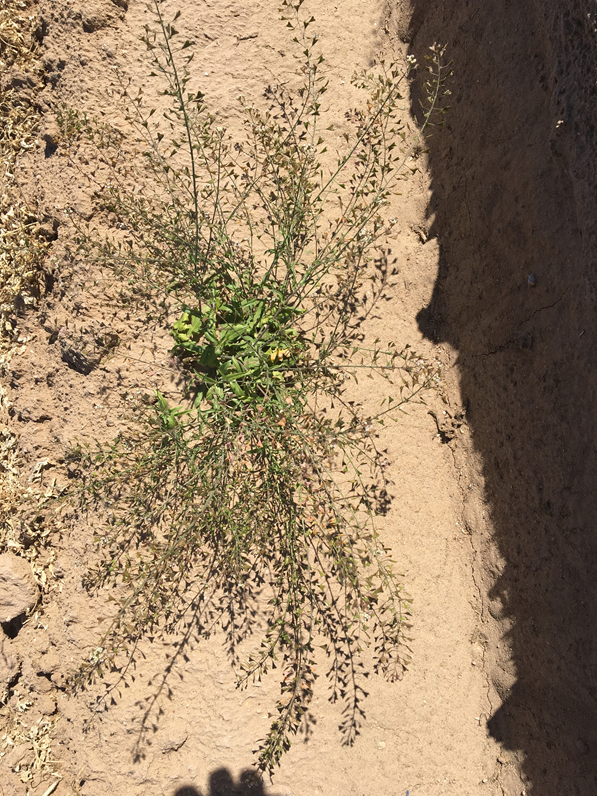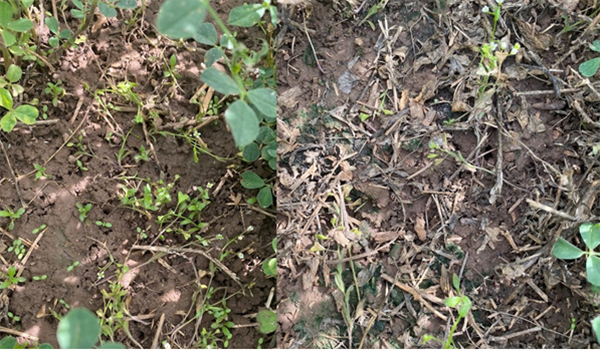



It’s unfortunately a very great season to be a plant pathologist…
We have confirmed the first sample of Fusarium wilt on lettuce submitted to the Yuma Plant Health Clinic from Yuma County. The stunted seedlings looked like any other typical case of damping-off at the seedling stage. When plated on culture media, subsequently confirmed Fusarium colonies grew abundantly from the declining plant tissues. If you’re not already on guard and scouting, this is a warning that Fusarium is active in Yuma County.
Adding on to this early alert, we’ve received a surge of submissions of young brassicas to the clinic. Several severely wilted and declining plants from around Yuma County have cultured positive for Pythium, likely as an opportunistic invader coming in on the back of all the early-season rain that brought stress to seeds and young transplants. Growers may want to consider oomycides, but only if the seedling disease is first confirmed to be Pythium. Remember, many seedling diseases caused by true fungi are indistinguishable from those caused by Pythium.
If you have any concerns regarding the health of your plants/crops please consider submitting samples to the Yuma Plant Health Clinic for diagnostic service or booking a field visit with me:
Chris Detranaltes
Cooperative Extension – Yuma County
Email: cdetranaltes@arizona.edu
Cell: 602-689-7328
6425 W 8th St Yuma, Arizona 85364 – Room 109
Shallowing steaming soil for weed control in spinach and baby leaf lettuce crops – machine in action and trial results (>89% weed control) video. Watch it here!
Fig. 1. Steam applicator principally comprising a 63 BHP steam generator
mounted on a bed-shaper applicator sled for killing weed seed prior to planting.
Steam applicator injects steam as beds are formed.After cooling (< ½ a day), the
crop is planted into the disinfested soil.
We have seen abundant Shepherdspurse recently in Yuma, AZ. Most of us are familiar with this winter annual broadleaf weed but we are adding a brief description:
Scientific name: Capsella bursa – pastoris
Season: Winter Annual
Habitat: Present in all crops and ditch banks, home gardens.
Cotyledons: Oval with a short petiole.
Leaves: First true leaves with hairs and spoon shape. Can have different shapes and form a rosette soon after emergence.
Young plants: Are mostly basal rosettes.
Mature plants: grow up to 20” with flower stems with sparse small leaves.
Flowers and Fruit: Flowers are pale pink and fruits are heart shaped or triangular seed pods.
Shepherdspurse is from the mustard or crucifer family, which includes many crops grown here such as broccoli, cauliflower, kale, kohlrabi, mustard greens and others.
In our production practices we commonly select some weed species that survive our methods of control. This weed has been around for a long time and has become increasingly widespread in recent years. The similarities with brassica crops add to the difficulty to control the weed as well as plant characteristics and growth habits.
In vegetables, Kerb can control shepardspurse when the product placed in the seed germination area close to the surface. If the product leaches the efficacy decreases. Dacthal, Prefar, Prowl, and Balan are less effective on this weed1.
Shepherspurse has proliferated in alfalfa recently and we are conducting some trials for its control. The results will be shared with PCAs and posted in our website when we finish collecting the data.


Fig 1. Images of an untreated plot compared to Raptor + Pursuit + Butyrac 200 +
NIS in alfalfa 4DAT.
Reference:
1.https://ag.arizona.edu/crops/vegetables/advisories/more/weed31.html
2.https://ipm.ucanr.edu/PMG/WEEDS/shepherdspurse.html#:~:text=Mature%20plant&text=Leaves%20vary%20in%20shape%20and,reduced%20in%20size%2C%20and%20stalkless.
This time of year, John would often highlight Lepidopteran pests in the field and remind us of the importance of rotating insecticide modes of action. With worm pressure present in local crops, it’s a good time to revisit resistance management practices and ensure we’re protecting the effectiveness of these tools for seasons to come. For detailed guidelines, see Insecticide Resistance Management for Beet Armyworm, Cabbage Looper, and Diamondback Moth in Desert Produce Crops .
VegIPM Update Vol. 16, Num. 20
Oct. 1, 2025
Results of pheromone and sticky trap catches below!!
Corn earworm: CEW moth counts declined across all traps from last collection; average for this time of year.
Beet armyworm: BAW moth increased over the last two weeks; below average for this early produce season.
Cabbage looper: Cabbage looper counts increased in the last two collections; below average for mid-late September.
Diamondback moth: a few DBM moths were caught in the traps; consistent with previous years.
Whitefly: Adult movement decreased in most locations over the last two weeks, about average for this time of year.
Thrips: Thrips adult activity increased over the last two collections, typical for late September.
Aphids: Aphid movement absent so far; anticipate activity to pick up when winds begin blowing from N-NW.
Leafminers: Adult activity increased over the last two weeks, about average for this time of year.







